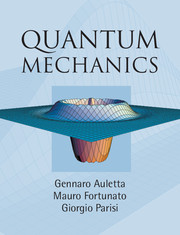Book contents
- Frontmatter
- Contents
- List of figures
- List of tables
- List of definitions, principles, etc.
- List of boxes
- List of symbols
- List of abbreviations
- Introduction
- Part I Basic features of quantum mechanics
- 1 From classical mechanics to quantum mechanics
- 2 Quantum observables and states
- 3 Quantum dynamics
- 4 Examples of quantum dynamics
- 5 Density matrix
- Part II More advanced topics
- Part III Matter and light
- Part IV Quantum information: state and correlations
- Bibliography
- Author index
- Subject index
3 - Quantum dynamics
Published online by Cambridge University Press: 05 June 2012
- Frontmatter
- Contents
- List of figures
- List of tables
- List of definitions, principles, etc.
- List of boxes
- List of symbols
- List of abbreviations
- Introduction
- Part I Basic features of quantum mechanics
- 1 From classical mechanics to quantum mechanics
- 2 Quantum observables and states
- 3 Quantum dynamics
- 4 Examples of quantum dynamics
- 5 Density matrix
- Part II More advanced topics
- Part III Matter and light
- Part IV Quantum information: state and correlations
- Bibliography
- Author index
- Subject index
Summary
In the first two chapters we have examined the basic principles – superposition (p. 18), complementarity (p. 19), quantization (p. 44), statistical algorithm (p. 57), and correspondence (p. 72) (see also Subsec. 2.3.4) – and the basic entities, observables and states, of quantum mechanics, as well as the main differences with respect to classical mechanics. While what we have discussed so far is rather a static picture of observables and states, in this chapter we shall deal with quantum dynamics, i.e. with the time evolution of quantum-mechanical systems.
Historically, after Bohr had provided a quantized description of the atom (see Subsec. 1.5.4), Einstein showed the quantized nature of photons (see Subsec. 1.2.1), and de Broglie hypothized the wave-like nature of matter (see Subsec. 1.5.5), the first building block of quantum mechanics was provided by the commutation relations, proposed by Heisenberg in 1925, whose consequence is represented by the uncertainty relation (see Subsec. 2.2.7 and Sec. 2.3). This was the subject of the previous chapters. The dynamical part of the theory was proposed by Schrödinger in 1926, and is known as the Schrödinger equation. It is also known as wave mechanics (see Subsec. 1.5.7). In this chapter we shall show that Heisenberg's and Schrödinger's formulations are only two different aspects of the same theory. We shall also come back to this point in Sec. 8.1.1. Here, first we shall derive the fundamental equation which rules quantum dynamics (Sec. 3.1), and, in Sec. 3.2, we shall summarize the main properties of the Schrödinger equation.
- Type
- Chapter
- Information
- Quantum Mechanics , pp. 100 - 140Publisher: Cambridge University PressPrint publication year: 2009



